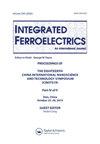zr4 +取代b位增强无铅BNSLT陶瓷的介电和储能性能
IF 0.7
4区 工程技术
Q4 ENGINEERING, ELECTRICAL & ELECTRONIC
引用次数: 0
摘要
摘要:采用固态燃烧法制备了(Bi0.38Na0.30Sr0.28)0.98La0.02Ti1-xZrxO3(简称BNSLT1-xZrx, x = 0−0.05)无铅陶瓷。研究了陶瓷的相结构、微观结构和电性能。在所有样品中均发现了菱形(R)相和四方(T)相的共存。Rietveld细化证实,当x从0增加到0.05时,菱形体相从41%增加到60%。当x = 0.01时,R:T相比为49:51。所有陶瓷均呈现多边形晶粒形状,晶粒生长各向异性。陶瓷的平均晶粒尺寸在0.46 ~ 0.79µm之间。最佳Zr4+含量可以促进晶粒生长,减少气孔,从而改善电学性能。在x= 0.01条件下,由于具有形态取向相边界(MPB)和良好的形貌,获得了最高密度(5.52 g/cm3)、最大介电常数(εm=2156)、最大极化(Pmax=15.36µC/cm2)和较高的储能性能(60 kV/cm时Wtotal=0.49 J/cm3、Wrec=0.45 J/cm3、Wloss=0.05 J/cm3和η = 90.54%)。致谢致谢致谢致谢致谢致谢致谢致谢致谢致谢致谢致谢致谢致谢致谢致谢致谢致谢致谢致谢致谢致谢致谢致谢致谢致谢致谢致谢致谢致谢致谢致谢致谢致谢致谢致谢致谢致谢致谢致谢致谢致谢致谢致谢致谢致谢致谢致谢致谢致谢致谢致谢致谢感谢Kyle V. Lopin博士助理教授对本文的编辑工作。披露声明作者未报告潜在的利益冲突。本研究由国家科学研究与创新基金(NSRF)通过南京大学资助[R2565B059]。N. Vittayakorn的工作得到了KMITL的支持。KREF116501]。本文章由计算机程序翻译,如有差异,请以英文原文为准。
Enhancement of the Dielectric and Energy Storage Properties of Lead-Free BNSLT Ceramics by Zr 4+ Substitution into B-Sites
Abstract(Bi0.38Na0.30Sr0.28)0.98La0.02Ti1-xZrxO3 (abbreviated as BNSLT1-xZrx, with x = 0 − 0.05) lead free ceramics were fabricated using the solid-state combustion method. The phase structure, microstructure and electrical properties of the ceramics were investigated. The coexistence of the rhombohedral (R) and tetragonal (T) phases was found in all samples. Rietveld refinement confirmed that as x increased from 0 to 0.05, the rhombohedral phase increased from 41 to 60%. A nearly equal R:T phase ratio of 49:51 was obtained for x = 0.01. All ceramics displayed polygonal grain shapes with anisotropic grain growth. The average grain size of the ceramics was in the range of 0.46–0.79 µm. The optimal Zr4+ content resulted in increased grain growth and reduced pores, leading to improved electrical properties. The highest density (5.52 g/cm3), maximum dielectric constant (εm=2156), maximum polarization (Pmax=15.36 µC/cm2) and high energy storage properties (Wtotal=0.49 J/cm3, Wrec=0.45 J/cm3, Wloss=0.05 J/cm3 and η = 90.54% at 60 kV/cm) were obtained from x = 0.01 caused by a morphotropic phase boundary (MPB) and good morphology.Keywords: BNT-basedphase structuremicrostructuredielectricferroelectric AcknowledgmentsThe authors thank the Department of Physics, Faculty of Science, Naresuan University for their supporting facilities and Prof. Dr. David P. Cann, Oregon State University, for his assistance with polarization-electric field (P-E) hysteresis loop measurements. Thanks, are also given to Asst. Prof. Dr. Kyle V. Lopin for his help in editing the manuscript.Disclosure StatementNo potential conflict of interest was reported by the author(s).Additional informationFundingThis work was supported by The National Science, Research and Innovation Fund (NSRF) through Naresuan University [R2565B059]. The work of N. Vittayakorn was supported by KMITL through [Grant No. KREF116501].
求助全文
通过发布文献求助,成功后即可免费获取论文全文。
去求助
来源期刊

Integrated Ferroelectrics
工程技术-工程:电子与电气
CiteScore
1.40
自引率
0.00%
发文量
179
审稿时长
3 months
期刊介绍:
Integrated Ferroelectrics provides an international, interdisciplinary forum for electronic engineers and physicists as well as process and systems engineers, ceramicists, and chemists who are involved in research, design, development, manufacturing and utilization of integrated ferroelectric devices. Such devices unite ferroelectric films and semiconductor integrated circuit chips. The result is a new family of electronic devices, which combine the unique nonvolatile memory, pyroelectric, piezoelectric, photorefractive, radiation-hard, acoustic and/or dielectric properties of ferroelectric materials with the dynamic memory, logic and/or amplification properties and miniaturization and low-cost advantages of semiconductor i.c. technology.
 求助内容:
求助内容: 应助结果提醒方式:
应助结果提醒方式:


